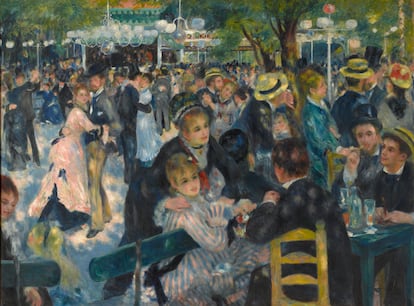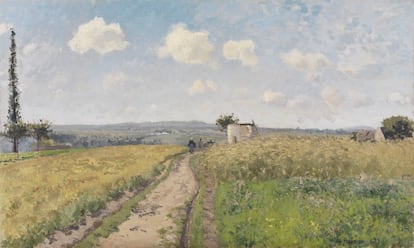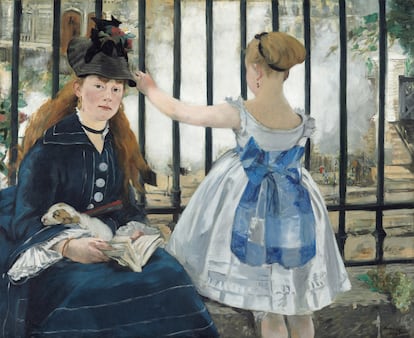150 years of Impressionism: the outcasts who altered the course of art history
France celebrates the anniversary of the art movement with an exhibition at the Musée d’Orsay, focusing on the first exhibition organized in 1874 by artists who challenged the establishment to paint modern life

The Impressionists’ first exhibition opened its doors 150 years ago, on April 15, 1874, in the former studio of renowned photographer Nadar in the heart of Paris. These Impressionists, including Monet, Renoir, Degas, Pissarro, Cézanne, Sisley and Morisot, had not yet been labelled as such and were treated as pariahs in the art world. They had been rejected, without exception, by the jury of the Salon — the official art exhibition of the Académie des Beaux Arts in Paris and the arbiter of good taste regarding the fine arts. The Impressionists wanted to present a new art form consisting of abrupt brushstrokes that were as fast-paced as modern life, yet with realism given less importance than the painter’s subjective perception, resulting in a mere impression.
The exhibition ran for just three weeks and was visited during that time by 3,500 members of the public. Only a handful of the paintings were sold, but the exhibition changed the course of art history. It challenged the hierarchies that governed the art market, reaffirmed the independence of the artist and kicked off an avant-garde century full of isms. France is now celebrating the anniversary of the Impressionism movement, one of its most significant exports, with a major exhibition at the Musée d’Orsay, Paris 1874. Inventing Impressionism, which addresses the original 1874 exhibition. The museum has also lent nearly 200 works of art to 34 museums throughout France, has an international colloquium on Impressionism scheduled for May and has also just launched an immersive installation that allows the public to tour the original exhibition. Meanwhile, Normandy, the Impressionists’ homeland, is organizing a festival dedicated to Impressionism, the highlight of which is an exhibition of Norman landscapes by David Hockney, perhaps Impressionism’s finest legatee, at the Musée des Beaux-Arts in Rouen.

The Impressionists again? One wonders what remains to be said about this movement and its members, whose revolution seems to be over, having become the subject of mainstream exhibitions and museum merchandising. The Paris exhibition, which boasts a total of 160 paintings — some of them on loan from the US and rarely seen in Europe — has chosen a new angle, that of demystifying the artists. “We tried to offer a more nuanced look at them, to move away from the heroic narrative and to stress that their initiative was in response not only to their artistic ambitions, but also to their commercial and career strategy,” says exhibition curator, Sylvie Patry. More than a manifesto against the established art world of the day, the 1874 exhibition was a coup — a cry for attention to combat the invisibility to which these Impressionists had been condemned by the Salon, the only existing channel available at the time to exhibit their work.
Despite being relegated to the margins, the Impressionists had an artistic agenda that had been years in the making. The so-called Société Anonyme that brought these painters together had two aims: to lighten the palette and to capture what was happening in the streets beyond the four walls of the studio. Napoleon III’s Paris had generated a new urban and bourgeois culture, a world of luxury and spectacle that was at its most intense along the grand boulevards, where the 1874 exhibition was inaugurated. It was a neighborhood that was under gentrification, hence the opening of the Garnier Opera. An exhibition had been proposed the previous decade, but the Paris Commune and the Franco-Prussian war, which France ended up losing, put the brakes on the initiative.

The movement would take its name from a painting by Monet included in the 1874 exhibition, Impression. Sunrise, now on display at the Musée d’Orsay. A little known critic, Louis Leroy, ridiculed the style in an article, suggesting an impression to be puerile subjectivity unworthy of art. But, in another gesture of brazen modernity, the Impressionists turned the insult into a badge of honor, though this did not happen until the group’s third exhibition, orchestrated by the painter Caillebotte in 1877 and considered the most impressionistic of their eight exhibitions; that is, the one that best reflected the present.
Another myth dismantled by the current Paris exhibition is that of the movement’s aesthetic unity: in the 1874 exhibition, only a third of the 200 paintings hanging on the burgundy-colored walls corresponded to the style we now identify with Impressionism. Moreover, the 31 participants were not all angry young men: there were 40 years between the oldest — Adolphe-Félix Cals — and the youngest — Léon-Paul Robert.
The highpoint of the current exhibition is contained in the rooms dedicated to the Salon, which allow us to understand why the work of these painters was such a thorn in the side of their contemporaries. The prevailing wisdom was that artists should stick to historical and religious subjects — to an art that always looked to the past and never to the present, with the exception of some tragic scenes of the last war that shocked the public in a departure that would seem to shore up the Impressionists’ argument.
Highlighting the names of the successful artists on the official circuit prior to Impressionsim — Gérôme, Henner, Bastien-Lapage — seems almost to be cruel as many are all but forgotten. There were, however, a few notable exceptions, such as Mary Cassatt, the American painter who would join the Impressionists just four years later, when they had managed to trump the popularity of their predecessors. Of all the big names, only Manet, a pivotal member of the group, preferred not to participate in the exhibition.

On the fifth floor of what was once a railway station, the succession of great Impressionist paintings in the Musée d’Orsay’s permanent rearlit collection is still breathtaking, however outdated the movement’s beliefs may now seem. “We are still aware of their bid for freedom, of the idea of challenging hierarchies, of taking into account a changing world and trying to capture the fugitive and the transitory,” says Patry. “Actually, these artists painted the origin of what we live today: the transformation of nature and the anthropocene, the tension between an appreciation and a rejection of modern life.”
In the landscapes, one detects a certain nostalgia for the pre-industrialized world — Pissarro, for example, went to great lengths to keep factories out of his frames — a relative paradox in a trend that always incorporated both urban and rural at once. Monet’s view of the port of Le Havre contrasts with his painting of the Gare Saint-Lazare. The artist knew how to detect the underlying beauty of a building that was then considered to be pre-brutalist. Cleverly, the exhibition focuses on the fact that these masters were not isolated geniuses, but responded to concerns shared by their contemporaries: the contrast of Impression, Sunrise with its views of the ocean and Study of Sky by Eugène Boudin, Monet’s mentor, generates a feeling of pure emotion. And it reminds anyone who has forgotten, that modernity was invented in the 19th century.
Sign up for our weekly newsletter to get more English-language news coverage from EL PAÍS USA Edition
Tu suscripción se está usando en otro dispositivo
¿Quieres añadir otro usuario a tu suscripción?
Si continúas leyendo en este dispositivo, no se podrá leer en el otro.
FlechaTu suscripción se está usando en otro dispositivo y solo puedes acceder a EL PAÍS desde un dispositivo a la vez.
Si quieres compartir tu cuenta, cambia tu suscripción a la modalidad Premium, así podrás añadir otro usuario. Cada uno accederá con su propia cuenta de email, lo que os permitirá personalizar vuestra experiencia en EL PAÍS.
¿Tienes una suscripción de empresa? Accede aquí para contratar más cuentas.
En el caso de no saber quién está usando tu cuenta, te recomendamos cambiar tu contraseña aquí.
Si decides continuar compartiendo tu cuenta, este mensaje se mostrará en tu dispositivo y en el de la otra persona que está usando tu cuenta de forma indefinida, afectando a tu experiencia de lectura. Puedes consultar aquí los términos y condiciones de la suscripción digital.
More information

The last Monet: Almost blind, abstract and undervalued
Archived In
Últimas noticias
Most viewed
- Oona Chaplin: ‘I told James Cameron that I was living in a treehouse and starting a permaculture project with a friend’
- Reinhard Genzel, Nobel laureate in physics: ‘One-minute videos will never give you the truth’
- Sinaloa Cartel war is taking its toll on Los Chapitos
- Why the price of coffee has skyrocketed: from Brazilian plantations to specialty coffee houses
- Silver prices are going crazy: This is what’s fueling the rally










































